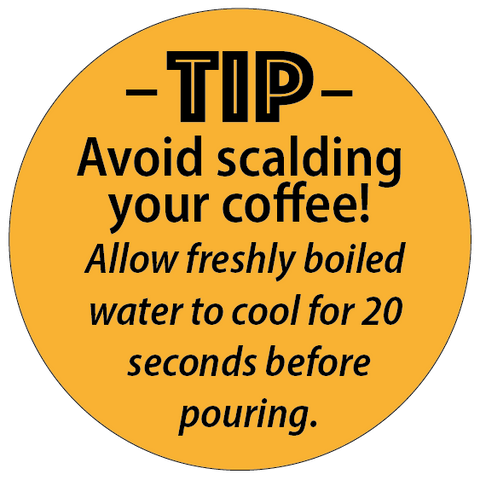BlindMan Coffee: How to Make Delicious Cafetière Coffee
A warm welcome from BMC to our pro barista Tips & Tricks page for cafetière - dedicated to removing some of the guesswork from brewing exceptional coffee in an excellent piece of kit.
With a few easy-to-do tried and tested tips, you may give a huge boost to your results and make extraordinary coffee.
If you'd like to go straight to the tips section - just scroll down the page. Or read the answers to a few of the questions we are so often asked about the best way to use a cafetière;
Q. Which is the best coffee to use for cafetière?
The short answer is to always buy the best quality, freshly roasted coffee you can find. If you already have our Blend No5 you're off to a great start. If you're not already buying BlindMan Coffee, our advice is to treat buying coffee the same way as everything else in life. That is to say: fancy labels in the supermarket or high prices are not a guarantee of quality.
- Not every coffee works well brewed in a cafetière. We designed Blend No5 especially to give outstanding results, so if you have some, great choice.
- All our coffee is freshly roasted for every order so you know it is the freshest you can buy because the roasting date is printed on every label.
- The label to the left will take you to our Blend No5 page if you click on it.
Q. How much coffee should I use in a cafetière?
Without meaning to state the obvious, the more coffee you use, the stronger the brew - that is probably no surprise! But do remember, adding more poor quality, old or stale coffee when searching for more or better flavour will just give you more old and stale flavours!. Freshness is key.
Clearly strength is a totally personal thing and perfection is achieved by playing with the amount, blend and roast of coffee of the coffee you use until you reach your perfect brew. If you have a light single origin such as Brazil Santos the flavour will be lighter, but if you're using on of our blends or, say our Monsoon Malabar or Sumatra with a deeper fuller roast and body then the flavour will be stronger and darker.
To begin with, try using around 1½ - 2 level tablespoons for a 3 cup (approximately 300ml/300g water) cafetière. If like us you prefer your coffee on the stronger side, use 2 level tablespoons (approx 15g) to 300ml/g of water and see what you think.
For a more precise approach you can use a brewing ratio which simply means measuring the amount of coffee to water to achieve a consistent result eg. 15g of coffee to 300ml/g of water is a ratio of 1:20 (one gram of coffee to every 20 grams/ml of water) although you might like a ratio more like 1:17 when using a lighter coffee.
Q. How should I grind coffee for a cafetière?
If you grind your own coffee beans you're already at an advantage as the lovely flavours of fresh coffee will not have escaped in the pack. Aim for a grind that is quite coarse - about the size of ground sea salt or fine sand. A good indicator is if, when you plunge the coffee, there is no resistance then grind a little more finely. If you have to really push the plunger then grind a little more coarsely.
Q. Is it OK to use boiling water to brew my coffee?

Never! Using boiling water will scald your coffee and almost certainly spoil the flavour. Start your brewing process by bringing fresh water to the boil. Once your kettle clicks off, leave it for 15-30 seconds before pouring. This pause is just enough to take the edge off the temperature.
Q. Should I stir the coffee when I add the hot water?
Yes you should. Pour in a couple of inches of hot water and gently stir once or twice just to make sure all the coffee is wet and there are no clumps of dry coffee lurking on the bottom or sides, then top up with the rest of your water.
Q. How long should I brew the coffee before plunging?

You might have come across all sorts of different recommendations for this but we recommend starting with 4 minutes. Darker roasts such as our blends will need a shorter brewing time. Lighter roasts, such as our Colombian single origin, will give its best flavour with a longer brew - try 41/2 mins. Start timing from the point you add the first water. If you detect sourness in your drink then increase the brew time by 15 seconds next time. If you detect bitterness then shorten it by a similar amount next time (sourness is usually caused by under-extraction and bitterness by over-extracting).
OUR CAFETIÈRE METHOD:
- Warm your cafetière by filling it with hot water - either from the hot tap or kettle - then push the plunger right down. This will prevent the cold metal and glass parts from cooling down your brew. Put the whole thing to one side for a minute while you find your coffee and scoop .
- If you grind your own beans - grind them now.
- Boil the amount of fresh water that you’ll need to make your coffee now - let it cool while you do the next bit (remember, boiling water will spoil your coffee so this rest is a good thing - it won't go cold in 15 seconds!)
- Empty out the hot water and carefully scoop in your coffee. Try to ensure the grounds go to the bottom and don't stick to the sides of the glass.
- Pour a couple of inches of water from your kettle onto the coffee and stir once or twice, gently, to wet all the coffee. Start your timer now and add the rest of the water
- Carefully put the plunger part into the top of the glass so the circular mesh part is just above (not touching) the coffee.
- When the timer goes, slowly plunge through the coffee and pour.
- That's it!
A Few Extra Tips:
- If you think the coffee is not strong enough - don't be tempted to extend the brewing time as doing that will likely cause bitter flavours due to over-extraction. Instead, add more coffee next time - or less if it’s too strong.
- If the flavour seems sour - allow 15-30 seconds extra brewing time - or if the flavour is bitter to you - shorten the brewing time by 15-30 seconds next time
- The plunger should move through the coffee quite smoothly and easily - if you feel you're having to push hard, then you're coffee is probably too finely ground (if you grind your beans) or you might simply be using too much coffee
- If the plunger pushes nice and easily but you find lots of fine 'muddy' grounds at the bottom of your cup then your coffee is likely ground on the fine side - try grinding a notch coarser.


